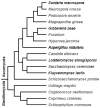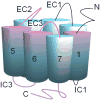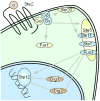Fungal mating pheromones: choreographing the dating game
- PMID: 21496492
- PMCID: PMC3100450
- DOI: 10.1016/j.fgb.2011.04.001
Fungal mating pheromones: choreographing the dating game
Abstract
Pheromones are ubiquitous from bacteria to mammals - a testament to their importance in regulating inter-cellular communication. In fungal species, they play a critical role in choreographing interactions between mating partners during the program of sexual reproduction. Here, we describe how fungal pheromones are synthesized, their interactions with G protein-coupled receptors, and the signals propagated by this interaction, using Saccharomyces cerevisiae as a reference point. Divergence from this model system is compared amongst the ascomycetes and basidiomycetes, which reveals the wealth of information that has been gleaned from studying pheromone-driven processes across a wide spectrum of the fungal kingdom.
Copyright © 2011 Elsevier Inc. All rights reserved.
Figures




Similar articles
-
Asymmetry in sexual pheromones is not required for ascomycete mating.Curr Biol. 2011 Aug 23;21(16):1337-46. doi: 10.1016/j.cub.2011.06.054. Epub 2011 Aug 11. Curr Biol. 2011. PMID: 21835624 Free PMC article.
-
Basidiomycete mating type genes and pheromone signaling.Eukaryot Cell. 2010 Jun;9(6):847-59. doi: 10.1128/EC.00319-09. Epub 2010 Feb 26. Eukaryot Cell. 2010. PMID: 20190072 Free PMC article. Review.
-
Mating in mushrooms: increasing the chances but prolonging the affair.Trends Genet. 2001 Jul;17(7):393-400. doi: 10.1016/s0168-9525(01)02343-5. Trends Genet. 2001. PMID: 11418220 Review.
-
Tetrapolar fungal mating types: sexes by the thousands.FEMS Microbiol Rev. 1996 Mar;18(1):65-87. doi: 10.1111/j.1574-6976.1996.tb00227.x. FEMS Microbiol Rev. 1996. PMID: 8672296 Review.
-
Phospholipase D1 is required for efficient mating projection formation in Saccharomyces cerevisiae.FEMS Yeast Res. 2001 Dec;1(3):225-32. doi: 10.1111/j.1567-1364.2001.tb00038.x. FEMS Yeast Res. 2001. PMID: 12702348
Cited by
-
The AngFus3 Mitogen-Activated Protein Kinase Controls Hyphal Differentiation and Secondary Metabolism in Aspergillus niger.Eukaryot Cell. 2015 Jun;14(6):602-15. doi: 10.1128/EC.00018-15. Epub 2015 Apr 17. Eukaryot Cell. 2015. PMID: 25888553 Free PMC article.
-
Extending the reach of homology by using successive computational filters to find yeast pheromone genes.Curr Biol. 2023 Oct 9;33(19):4098-4110.e3. doi: 10.1016/j.cub.2023.08.039. Epub 2023 Sep 11. Curr Biol. 2023. PMID: 37699395 Free PMC article.
-
Variation in mate-recognition pheromones of the fungal genus Microbotryum.Heredity (Edinb). 2016 Jan;116(1):44-51. doi: 10.1038/hdy.2015.68. Epub 2015 Aug 26. Heredity (Edinb). 2016. PMID: 26306729 Free PMC article.
-
Altered GC- and AT-biased genotypes of Ophiocordyceps sinensis in the stromal fertile portions and ascospores of natural Cordyceps sinensis.PLoS One. 2023 Jun 8;18(6):e0286865. doi: 10.1371/journal.pone.0286865. eCollection 2023. PLoS One. 2023. PMID: 37289817 Free PMC article.
-
Parasex Generates Phenotypic Diversity de Novo and Impacts Drug Resistance and Virulence in Candida albicans.Genetics. 2017 Nov;207(3):1195-1211. doi: 10.1534/genetics.117.300295. Epub 2017 Sep 14. Genetics. 2017. PMID: 28912344 Free PMC article.
References
-
- Aimi T, et al. Identification and linkage mapping of the genes for the putative homeodomain protein (hox1) and the putative pheromone receptor protein homologue (rcb1) in a bipolar basidiomycete, Pholiota nameko. Curr Genet. 2005;48:184–194. - PubMed
-
- Anderegg RJ, et al. Structure of Saccharomyces cerevisiae mating hormone a-factor. Identification of S-farnesyl cysteine as a structural component. J Biol Chem. 1988;263:18236–18240. - PubMed
Publication types
MeSH terms
Substances
Grants and funding
LinkOut - more resources
Full Text Sources
Molecular Biology Databases

